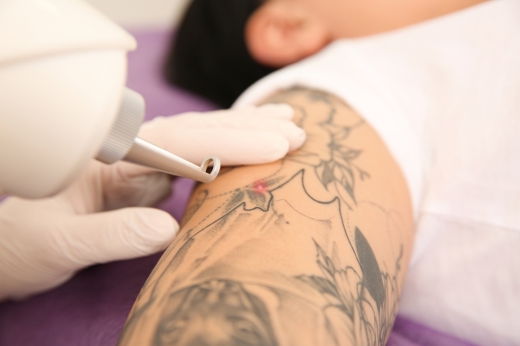
Tattoos have become increasingly popular today, especially in metropolitan and developed cities. They are a symbol of fashion or the transformation of an important event into something memorable. Tattoos are permanently inked into your body and cannot be removed. Earlier, surgical removal was possible, but it had its share of drawbacks, like pain, discomfort, unpredictable results, and permanent scarring.
However, with advanced technology and cutting-edge innovation, tattoos can be removed easily and minimally invasively. The limitations of surgical removal led to the rise of laser tattoo removal treatment. Lasers used for tattoo removal by dermatologists (doctors specializing in the diagnosis and treatment of conditions related to the skin, hair, and nails) offer excellent results with minimal scarring.
A tattoo is a permanent depiction, image, or body modification in which an artist injects special dyes and inks into your skin. These ink particles are foreign substances inked into your body, but since they are large, your immune system cannot easily remove them. Thus, the pigments remain inked into your body permanently below the skin surface.
Tattoo removal involves procedures to remove this permanent ink from your body. It is a complex procedure that requires several sessions to complete. There are several tattoo removal options, the most common and popular being laser tattoo removal.
Laser tattoo removal helps diminish the appearance of unwanted tattoos. Your dermatologist will use lasers to emit high-intensity light pulses during the procedure. This light targets the permanent ink inside your tattoo but leaves the skin around it unharmed. As the ink absorbs the light, it begins to heat up. The heat energy makes the ink break down into small particles. Your immune system will be able to clear the tiny particles of ink, and the tattoo will begin to fade gradually.
In general, this is what you can expect during a laser tattoo removal session:
You may require several sessions of laser emission, and the tattoo may get lighter after each session. Each session may take somewhere around 10 to 15 minutes.
Laser tattoo removal can be uncomfortable, but most patients tolerate it well due to the use of numbing agents in the form of injectables or numbing creams. Furthermore, dermatologists use cooling gels or ice packs after the procedure to ease discomfort, soreness, and swelling.
Your doctor may also prescribe pain medications before and after laser tattoo removal treatment. The pain intensity felt depends on the location of the tattoo and the kind of lasers used by doctors.
Your doctor or dermatologist will guide you on caring for your skin after each laser tattoo removal session.
The following tips can help your skin heal and prevent scarring:
Laser tattoo removal treatment is an excellent alternative to surgical removal due to the following benefits:
As with any procedure, there are potential risks associated with laser tattoo removal treatment. However, these side effects are minimal and temporary. They resolve on their own gradually. The side effects include the following:
"Think before you ink!"- As the old proverb goes, it is important to re-consider before getting a tattoo. Since tattoos are always permanent, getting them removed can be very painful. But not anymore! With recent advances in laser technology, you can remove your tattoos easily with minimal invasiveness and scarring. But remember to get laser tattoo removal treatment by a qualified dermatologist and modern laser equipment. These are considerably safe and effective when compared to conventional surgical methods that leave behind ugly scars.